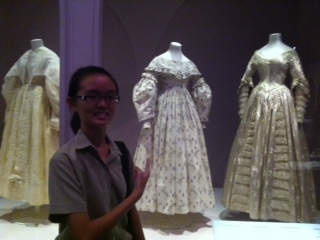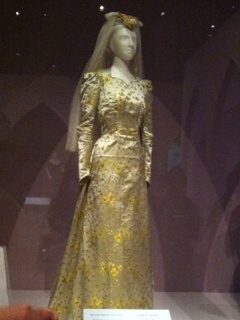1) Find a particular wedding dress that you find interesting. What do you think is the identity of the bride wearing this dress? Elaborate on and explain your answer. Substantiate your ideas with analysis of the dress.
The identity of the bride, Sarah Maria Wright, wearing the wedding dress above is most likely that of a commoner. This is because firstly, the dress is made of cotton, which is a readily available material and hence is cheaper than other more exquisite types of fabric such as silk. Therefore, the fact that she was only able to afford a cotton wedding dress shows that she was not wealthy and probably of the working class. As compared to the other dresses shown in the exhibition, this dress was a simple one that does not have any embroidery added on, but only designs printed on it. This further suggests that the couple could only afford and make use of the available and cheap resources around them, like block printing which was modern in 1841 and manufactured at their area, the countryside.
In addition, it was found that the seams on the back of the dress had been loosened by a few inches, suggesting that the bride had worn the dress several times after her wedding, and even when she was pregnant. Therefore, this implies that the bride could have had limited clothing due to her lack of wealth, thus causing her to have to re-wear her wedding dress many times. Also, the bride was most likely a farmer or one who did manual labour due to the colourful prints and cutting of the dress. The bride’s reason for choosing a colourful wedding dress could have been that it would be more practical as compared to a white one, which would become dirty more easily when she worked. In addition, the ill-fitting cutting of the dress allowed for greater ease of movement, which would hence enable her to work more efficiently, as opposed to a figure-hugging wedding dress which would restrict her movement if she re-wore the dress during work.
Moreover, the print’s on the bride’s dress consisted of pearls and ribbons. The fact that such jewellery was printed onto the dress suggested that the bride might have been unable to afford wearing such accessories during her wedding and hence, had them printed onto her wedding dress as a representation instead. The patterns on her dress were also printed and not embroidered by hand onto her dress, which would have been more expensive, showing that she may not have had been able to afford it. Therefore, it can be seen that because the bride had most likely not been wealthy and was probably a farmer or labourer, her identity was that of a commoner.


2) Find a dress whose style is very much reflective of the times when it is created. Explain clearly your ideas.



The maker of this dress added in some buttercup flowers as design to this otherwise dull dress. It was most probably added to brighten up the mood of this wedding, especially when it was held during times of crisis. Moreover, perhaps due to military influence during the war, the shoulder seemed to be more stiff and broad, resembling a typical military uniform.
2) Find a dress whose style is very much reflective of the times when it is created. Explain clearly your ideas.
This dress was made in 1941, during World War Two. At that time, fabric rationing was practised, so there was a shortage of fabric. This resulted in wedding dresses, such as the one above, being made using cheaper alternative upholstery material. Hence, upon closer look, one can identify with a change in texture of the dress compared to dresses made with fabric.
The maker of this dress added in some buttercup flowers as design to this otherwise dull dress. It was most probably added to brighten up the mood of this wedding, especially when it was held during times of crisis. Moreover, perhaps due to military influence during the war, the shoulder seemed to be more stiff and broad, resembling a typical military uniform.
The flowers seen on the bride’s head are Orange Blossoms which signify fertility, because the orange tree is the only tree which is able to bear fruits and flowers simultaneously. The bride’s veil helped to cover up her expressions of sadness and anxiety on her wedding day.
In addition, the hemline of the dress dropped, which is characteristic of dresses made during wartimes when the economy was poor. The cutting , designs and color of this dress were much simpler and less flamboyant as compared to other dresses worn during the pre-war period. this helped to bring out the more conservative and watchful side of these women which suited the solemn atmosphere brought out by the war. Lastly, many women were needed to help out during the times of war, and they needed comfortable clothing which allowed movement. Hence, this dress was a ready-made one, which the bride could wear ‘off the rack’ whenever she wants, even after her wedding.
All in all, these are the main details on the dress, shown in the pictures above, which helped to reflect the times at which this dress was created.
No comments:
Post a Comment